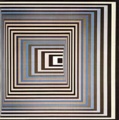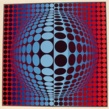
Examples of Op Art:

Maurits Cornelis Escher (Dutch, 1898-1972),
Balcony, 1945, lithograph,
11 3/4 x 9 1/4 inches (29.7 x 23.4 cm), National Gallery of Art,
Washington, DC. In the center of this picture of a hillside town,
Escher said he tried to break up the paper's flatness by "pretend[ing]
to give it a blow with my fist at the back, but . . . the paper
remains flat, and I have only created the illusion of an illusion."
Maurits Cornelis Escher, Up and Down, 1947, lithograph, 19 3/4 x 8 1/8 inches (50.3 x 20.5 cm).

Maurits Cornelis Escher, Drawing Hands, 1948, lithograph,
11 1/8 x 13 1/8 inches (282 x 332 mm).

Maurits Cornelis Escher, Relativity, 1953, lithograph,
11 1/8 x 11 5/8 inches (282 x 294 mm), National Gallery of Art,
Washington D.C. Here three worlds, each with their own gravitational
forces exist simultaneously, operating perpendicularly to one
other.

Maurits Cornelis Escher, Convex and Concave, 1955, lithograph. See convex
and concave.

Maurits Cornelis Escher, Belvedere, 1958, lithograph,
8 1/4 x 11 5/8 inches (462 x 295 mm), National Gallery of Art,
Washington, DC. This belvedere has three stories, but its drawing
results in an optical illusion. Escher has employed a hybrid
of linear perspective
that produces a mixture of two possibilities. Note how the pillars connect the second
to the third story.

Maurits Cornelis Escher, Waterfall, 1961, lithograph,15
x 11 3/4 inches (380 x 300 mm).

Victor Vasarely (French, born Hungary, 1908-1997),
Basilan II, 1951-1958, acrylic
paint, 60 cm x 65 cm, Tehran Museum of Contemporary Art,
Iran. Vasarel's geometric
paintings of the 1950s moved gradually toward optical art.

Victor Vasarely, OB-NEG, 1955, oil
on canvas, 140 cm x 220
cm, Tehran Museum of Contemporary Art, Iran.

Victor Vasarely, Quasar-Fugue, 1966-1973, oil
on canvas, 150.5 x 150.5
cm, Tehran Museum of Contemporary Art, Iran.

Victor Vasarely, unidentified op art image, black
and white.
![]()

Victor Vasarely, Blue-Black.

Victor Vasarely, Blue / Red, 1983, silkscreen, from an edition
of 267, 23 x 23 inches (58.5 x 58.5 cm.

Victor Vasarely, Zebra, 1987, silkscreen, from an edition
of 200, sheet: 50 x 45 cm, print 38.5 x 35.4 cm.
Ad Reinhardt (American, 1913-1967), Black Painting No. 34, 1964, oil on canvas, 60 1/4 x 60 1/8 inches (1.530 x 1.526 m), National Gallery of Art, Washington, DC. See Abstract Expressionism and Minimalism.
Yaacov Agam (Israeli, 1928-), The Ninth Power, 1970-71, stainless steel, 70 3/4 x 70 x 70 inches, Albright-Knox Art Gallery, Buffalo, NY. See Jewish art.
![]()

Bridget Riley (British, 1931-), Intake.

Bridget Riley, Cataract.

Bridget Riley, June, 1992, silkscreen, edition of 75, 80 x 114.3
cms (31 1/2 x 45 inches).
Also see optical illusion, Pop Art, tessellation, and trompe l'oeil.
https://inform.quest/_art